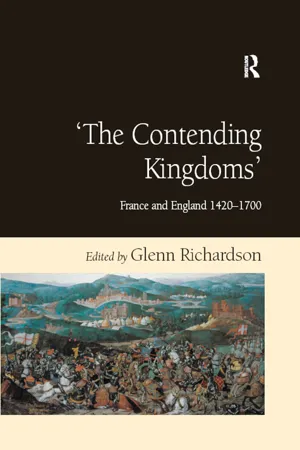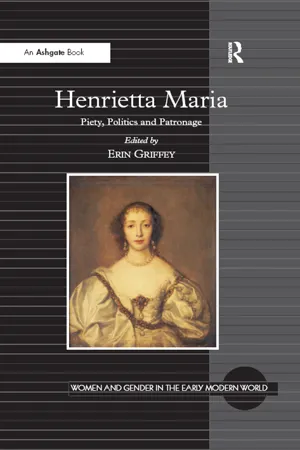History
Catherine de' Medici
Catherine de' Medici was an influential figure in 16th century France, serving as queen consort and later regent. Known for her political acumen and involvement in the Wars of Religion, she wielded significant power and navigated complex religious and political tensions. Catherine's legacy is marked by her efforts to maintain stability and control during a tumultuous period in French history.
Written by Perlego with AI-assistance
Related key terms
3 Key excerpts on "Catherine de' Medici"
- eBook - ePub
On Power
Psychoanalytic Inquiry, 6.1
- Melvin Bornstein(Author)
- 2014(Publication Date)
- Routledge(Publisher)
In December of 1560, after 26 years of obscurity, Catherine dé Medici at the age of 41 unexpectedly took upon herself the government of France as active Regent for her second son, Charles IX. Thus began a lengthy reign during the Wars of Religion in which this Italian woman dominated French politics despite great unpopularity. There were, in fact, many who might have described her as “infamous” for her complicated but central role in the St. Bartholomew’s Day massacre of the Huguenots. Many enigmas surround this unpredictable woman. How did so seemingly unpromising a person, at age 41, survive so well in a dangerous era while wielding great power against strong opposition inside and outside France? An alternative question is, given her skill in political maneuvering, what accounts for the long period of obscurity preceeding 1560? Perhaps a review of what is known of her youth will provide clues to help us understand the unique personality of this woman. The principal sources of our historical data for Catherine are Heretier (1963), Mahoney (1975), Sichel (1969), and Sutherland (1973).When Catherine dé Medici was born in Florence in 1519 the economic glory of the Medici family was literally spent. She was the last of the legitimate line, and that she was female was regarded as a disaster. Both her mother and father (to whom Machiavelli had dedicated The Prince) died within days of her birth. Her guardians were men, primarily her granduncle, Giulio dé Medici, who later became Pope Clement VII, and the then current Pope, Leo X, also a Medici. While she was sporadically cared for by her aunt Clarice Strozzi and her grandmother, it is probably crucial to her development and processes of identification that in the main her female caretakers were servants and her principal models were male. Her removal from Florence to Rome when she was seven months old separated her from her aunt; her grandmother died when Catherine was a year old.She lived in Rome until she was six years old. Fragile from birth, she was several times thought to be on the brink of death. Before the age of three, she suffered three serious object losses, either by death or separation: her parents, her grandmother, and her first guardian, Clarice Strozzi. - eBook - ePub
'The Contending Kingdoms'
France and England 1420–1700
- Glenn Richardson(Author)
- 2017(Publication Date)
- Routledge(Publisher)
Chapter 7 Elizabeth I and Catherine de’ Medici Susan DoranAn examination of the relationship between Elizabeth I and Catherine de’ Medici might seem an odd, or even inappropriate, topic for a collection of essays on Anglo-French relations inspired by the centenary of the Entente-Cordiale. An objection might be raised that Catherine cannot legitimately be treated as a representative of France as she was neither born nor acted as queen regnant there. Yet, although a native of Florence, Catherine was more French than anything else. She had moved away from Italy in 1533 when she was a young girl of 13; she wrote and spoke French fluently and was imbued with the culture of the Valois court. Furthermore, while never a queen regnant, from the time of her husband’s death in July 1559 until her own in January 1589, Catherine as la reine-mére played a significant role in French political life, influencing both French domestic affairs and international relations. Her voluminous correspondence is testimony to her close involvement in public affairs. The English State Papers, moreover, make clear that Queen Elizabeth and her ambassadors took Catherine very seriously indeed as a major political player, especially during the reigns of her younger sons, Charles IX and Henry III.It is true that during the 17 months when her eldest son, Francis II, was on the throne Catherine’s influence was thought to be limited compared with that of the Guise family, especially Francis, Duke of Guise, and Charles, the cardinal of Lorraine who were the uncles of the new king’s wife, Mary Queen of Scots. Thus, on 11 July 1559, Sir Nicholas Throckmorton, the English ambassador, reported gloomily that ‘the house of Guise is like to govern all about the King, who is much affected towards them’, and two days later he pronounced: ‘The House of Guise ruleth’. Nonetheless, even during this period, Catherine’s importance was acknowledged. By the end of July, Throckmorton was reporting that the dowager queen had been given the new title of la reine mère and ‘hath thoughe not in name, yet in dede and in effect th’authorite of the Regent to the French King’.1 At the death of Francis II, Catherine did indeed become regent to her second son, Charles, and from then on, well beyond her three years as regent, she was recognised as a significant force within the realm.2 In their dispatches to England, Elizabeth’s envoys reported time and again on Catherine’s informal power at court, and especially her influence over her sons. In late 1560 Throckmorton described Catherine as ‘tutrix’ to the young Charles IX, and a little later Francis Russell, Earl of Bedford, reported that ‘the Quene Mother dothe most thinges here’.3 In January 1569, Sir Henry Norris recounted a particular incident when Catherine would not allow the king, then aged 20, to sign some letters of importance,4 and a few years later, Sir Francis Walsingham reported that Catherine’s power was paramount and ‘the governement rests wholie in her hands’.5 Throughout the reign of the adult Henry III, the king was generally believed to be dominated by his mother. ‘[The] Queen Mother commandeth very much’, wrote Sir Henry Cobham in November 1579.6 Even after she had become debilitated through age and illness, she was thought to be the king’s trusted adviser: ‘the king’, wrote Sir Edward Stafford in May 1587, ‘[is] ever used in all things of weight to acquaint his mother with it’. The following year Stafford commented that the queen mother ‘could bring him [the king] to do whatever she likes’.7 - eBook - ePub
Henrietta Maria
Piety, Politics and Patronage
- Erin Griffey(Author)
- 2016(Publication Date)
- Routledge(Publisher)
Chapter 5 The Three Marys: The Virgin; Marie de Médicis; and Henrietta Maria Jessica BellThe French queen, Marie de Médicis (1573–1642), was a prolific patron of the arts and, consequently, the resultant literature on her participation in the seventeenth-century art market has been abundant. Marie amassed an enormous painting collection which included works by some of the most pre-eminent contemporary local and international talent, but it is her patronage of Peter Paul Rubens that has generated the most discussion. Authors such as Jacques Thuillier and Jacques Foucart, Deborah Marrow, Susan Saward, Ronald Forsyth Millen and Robert Erich Wolf and more recently Geraldine A. Johnson have added much to the current understanding of Marie’s relationship with the Flemish painter which resulted in the twenty-four large-scale canvases depicting events from the French queen’s life which now hang in Salle 18 in the Louvre, but which originally decorated the western gallery of her personal residence: the Luxembourg Palace.1 Although these authors vary in their interpretations of specific signs and symbols, all note that Marie’s love of painting extended to a desire to use it to manipulate public perception and create an appropriate persona which highlighted her virtues.A great deal of Marie’s patronage was focused on building and decorating the Luxembourg Palace, the imposing private residence which she commissioned for herself in Paris (1612). It was within this palace that Marie developed much of her personal, highly recognizable iconography and hung much of her sizeable picture collection. Her intention in building such a grand residence was surely to create a sense of magnificence that she felt befitted someone of her position. The building is huge, consisting of a corps-de-logis
Learn about this page
Index pages curate the most relevant extracts from our library of academic textbooks. They’ve been created using an in-house natural language model (NLM), each adding context and meaning to key research topics.


